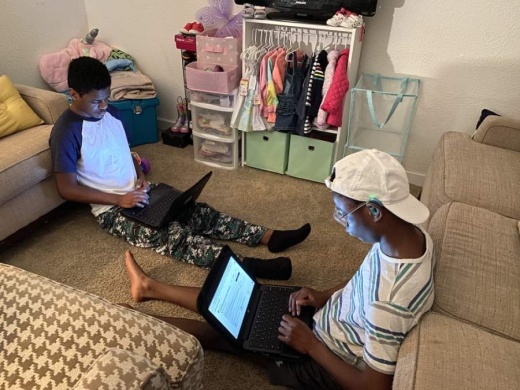“She is not going to be self-directed like a typical kid,” he said. “She has to be directed most or all the time.”
The transition to virtual learning has been challenging for all students, but children with disabilities face obstacles beyond those encountered by their neurotypical peers.
Samantha is nonverbal and uses an iPad to communicate. School is where she receives speech therapy, and while it has continued remotely, it is not as effective as it is in person, Laska said.
“Speech therapy is much better when someone is face to face, right there with her, giving her the amount of time she is entitled to, but she’s not really getting that same thing remotely,” he said.
The special needs program in Richardson ISD comprises roughly 5,000 students, or 12.4% of overall enrollment. Disabilities span a broad spectrum but include conditions such as autism, dyslexia, attention-deficit/hyperactivity disorder, speech impairments and more. Kristin Ho is a special education teacher who oversees eight students on the autism spectrum at Northwood Hills Elementary School. For Ho, the hardest part of the transition was helping her students understand the reason for the change in their everyday routine.
“Navigating such a new—hopefully—'not-normal' was really difficult, especially early on,” she said. “All of those conversations had to be replayed frequently because it’s just so abstract to them.”
Now, parents are more responsible than ever for their child’s academic progress, but those with special needs children are not necessarily versed in the various interventions needed to help them learn.
“We are experts on [Samantha], but we aren’t experts on education,” Laska said.
Jacquelyn Lloyd, whose sons, Malachi and Emmanuel, are enrolled in the special education program at JJ Pearce High School, said she is constantly looking over their shoulders to make sure they are staying on top of their schoolwork.
“My kiddos typically have a really, really hard time keeping up with everything,” she said. “If I wasn’t there to help, they would not be able to do it on their own.”
No matter how involved a parent is, a teacher’s ability to connect with students can make or break a child’s chance for success, Lloyd said. Malachi and Emmanuel’s math teacher, Mrs. Roberts, has been an example of how to effectively educate in this environment, she added.
“You can tell that she has taken the time to teach them how to maneuver around the Google Classroom and how to get to the different programs,” she said. “My children don’t even ask questions. In her class, they understand what they’re doing.”
In the early days of e-learning, Ho coordinated with her students’ parents to establish a routine. That partnership has continued throughout the shutdown, she said.
“I have a great set of parents who are very open to communicating with me,” Ho said. “We collaborate a whole lot on ways to help students at home.”
Ho meets with each student via Zoom twice a week for around 30 minutes. A standing agenda includes a review of the daily calendar as well as a reading or math activity. Each lesson plan is curated to accommodate the child’s specific needs, she said.
“I use a lot of visuals, a lot of positive reinforcement,” she said. “We’re still trying to target as many things as we can while having fun.”
For the remainder of the week, Ho said she assigns activities that focus on the review of already mastered skills rather than new concepts. Oftentimes, this is when parents step in.
“It comes with a lot of added challenges, but it’s the education of a child, and it’s very important,” Ho said. “My parents understand that.”
Lloyd said she has kept her sons on a regimented schedule. As much as possible, she has tried to recreate their normal routine.
“We definitely try to make it like it’s a school week, a school day, so that things are easier on them,” she said.
Face-to-face interaction with teachers is vital to a student’s well-being, Ho said.
The highlight of Samantha’s day is visiting with her teacher on Zoom, Laska said.
“It’s very important to have consistency for this type of kid,” he said. “So seeing her teacher is a very helpful thing.”
For Lloyd, educating Malachi and Emmanuel has been a team effort. Her mother, niece and nephew and older son all live in the home and are able to pitch in.
“It has been sometimes overwhelming for me as a parent because I am trying to navigate two children that have learning disabilities,” she said.
It may be a while before the district knows whether virtual learning resulted in academic setbacks. But Lloyd said Richardson ISD has positioned students to make it out of the shutdown relatively unscathed.
“I don’t feel that these kiddos will be at a disadvantage at all, not with the way the district has set them up,” she said.
Ho said it took a while for her to come to grips with the reality that she would not be returning to school this semester. In the meantime, she said she has committed to maintaining a positive attitude.
“We’re not going back to school this year, so let’s make the most of what we have,” she said. “We are thankful for the technology that enables us to do that.”





